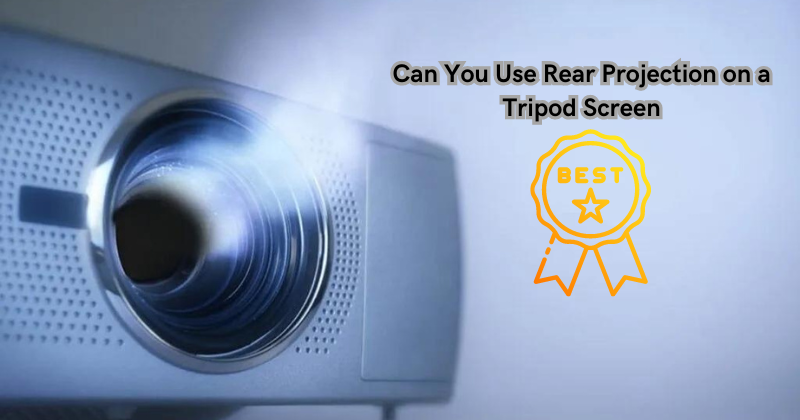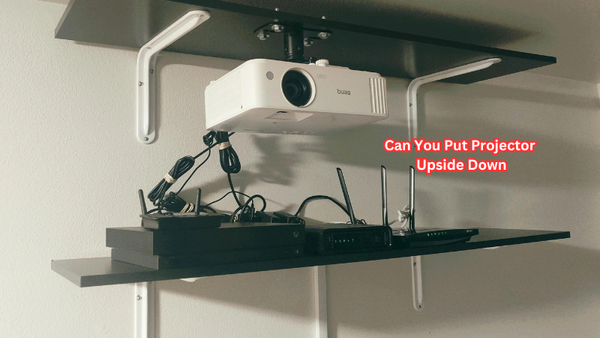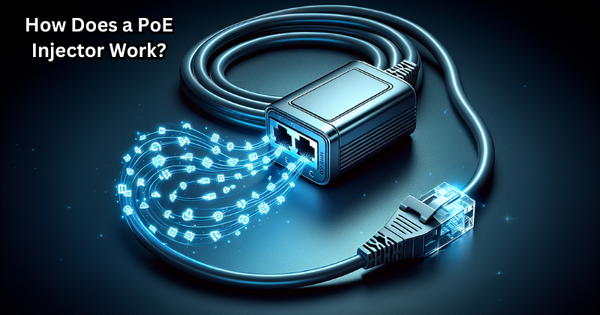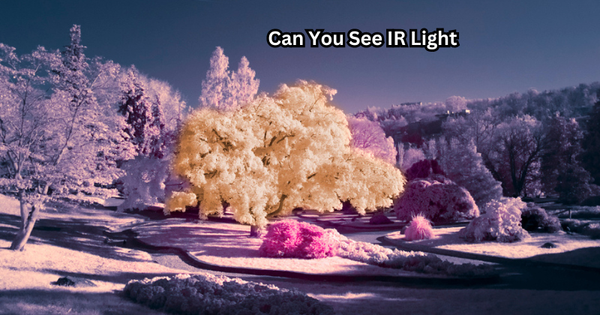Rear projection on a tripod screen offers a versatile solution for displaying content in various settings. By utilizing rear projection technology, the projector is positioned behind the screen, preventing shadows and obstructions, resulting in a clear, uninterrupted visual experience.
The use of a tripod screen provides portability and ease of setup, making it suitable for events, presentations, or impromptu gatherings. This setup allows for flexibility in positioning the screen, ensuring optimal viewing angles for the audience.
Whether for business presentations, educational purposes, or entertainment events, rear projection on a tripod screen combines convenience with high-quality visuals, enhancing the overall impact of the content being displayed.
What is Rear Projection Technology?
Rear projection technology involves projecting an image onto a translucent screen from behind, rather than in front.
This allows for the projector to be positioned out of sight, eliminating any potential disruptions to the content being displayed. A rear projection setup typically requires a dedicated screen or material that is specifically designed for this purpose.
The use of a tripod screen further optimizes this setup by providing stability and adjustability for the screen's position, ensuring optimal viewing angles for the audience.
Rear projection screens are typically made of special materials that enhance the projected image's brightness and contrast, resulting in a clear and vibrant display.
The rear projection screen material also has a wider viewing angle, allowing for better visibility from multiple directions. Another plus is that because a rear projector tends to be further away from the screen, it can produce a larger image while maintaining high resolution.
Overview of Tripod Screens for Projection
A tripod screen is a free-standing, portable screen that can be easily set up and taken down.
It typically consists of three legs with an adjustable height mechanism, a support structure for the screen material, and a carrying case for transportation. The screen fabric itself can vary in materials such as matte white, high-gain vinyl, or tensioned PVC.
Tripod screens are available in various sizes, making them suitable for different venues and events. They also come with features such as a black border to enhance the projected image's contrast and a keystone eliminator to correct any distortion caused by the projector's angle.
Some tripod screens even have a self-standing mechanism, eliminating the need for additional support structures, and further enhancing their portability and ease of setup. Rear and front projection options are also available for tripod screens.
Advantages of Using Rear Projection on a Tripod Screen
- Enhanced Visibility: By utilizing rear projection technology, shadows cast by the presenter or any obstructions in front of the screen are eliminated, providing an uninterrupted view for the audience. This results in a more engaging and immersive experience for the viewers.
- Portability and Versatility: The portability of tripod screens combined with rear projection technology makes them suitable for various settings and events. They can be easily transported, set up, and adjusted to fit different venues, making them a versatile solution for displaying content on the go.
- Superior Image Quality: Rear projection screens have a wider viewing angle and are designed to enhance the projected image's brightness and contrast. This results in a high-quality display that is visible from multiple directions, ensuring everyone in the audience has an optimal viewing experience.
- Cost-Effective Solution: Rear projection on a tripod screen offers a cost-effective solution compared to other setups such as front projection or LED screens. It eliminates the need for additional equipment, such as rigging or trussing, and can be set up without professional assistance, saving time and costs. Front projection screens also require a darker environment for optimal viewing, whereas rear projection screens are less affected by ambient light, providing more flexibility in location and event planning.
So, short-throw projectors are an excellent option for projecting on a tripod screen, making them a convenient and cost-effective solution for displaying content in various settings.
Can You Use Rear Projection on a Tripod Screen?
Yes, you can use rear projection on a tripod screen. This setup is suitable for various applications and venues, providing a versatile and cost-effective solution for displaying content.
Whether for business presentations, educational purposes, or entertainment events, this combination offers enhanced visibility, portability, superior image quality, and affordability.
Furthermore, advancements in technology have led to more compact and lightweight projectors, making it even easier to set up rear projection on a tripod screen.
With the flexibility and convenience that this setup offers, it is no wonder that it is a popular choice for many organizations and individuals looking to display content in an engaging and impactful way.
Considerations for Setup
Before setting up rear projection on a tripod screen, there are a few things to consider:
Lighting:
As with any projection setup, lighting plays a crucial role in the image quality. It is important to control the amount of ambient light in the room for optimal visibility. For front projection setup, a darker environment is necessary, but for rear projection on a tripod screen, ambient light can be managed more easily.
However, it is still important to minimize any direct light sources that may cause glare on the screen. Rear projection requires the light source to be placed behind the screen, so it is essential to have enough space and proper positioning for this setup.
Distance and Angle:
The distance between the projector and the screen will affect the size and clarity of the projected image. Be sure to check the projector's throw distance and angle specifications for your desired screen size.
Rear projection screens also have a wider viewing angle, so be mindful of the screen's placement to ensure optimal visibility for all audience members.
Screen Material:
Ensure that the screen material is specifically designed for rear projection, as it is different from front projection materials.
This will ensure optimal image quality and prevent any potential damage to the screen. Projector screen materials with a high gain will also provide better visibility in well-lit environments.
By taking these factors into consideration, you can achieve the best possible setup for rear projection on a tripod screen and elevate your content display to the next level. Projector models and screen materials vary, so be sure to research and select the best options for your specific needs.
Applications and Use Cases of Rear Projection on a Tripod Screen
Rear projection on a tripod screen has numerous applications and use cases, including:
- Business presentations
- Trade shows and exhibitions
- Educational lectures and training sessions
- Outdoor movie screenings
- Digital signage for events or retail spaces
The portability, versatility, and affordability of this setup make it suitable for various industries and event types.
It allows for a seamless and impactful display of content, enhancing the overall experience for both presenters and audience members. With rear projection on a tripod screen, short throw lens options, and compact projector models, the possibilities for displaying content are endless.
Practical Tips for Optimizing Rear Projection on a Tripod Screen
To ensure the best possible display of content with rear projection on a tripod screen, here are some practical tips to keep in mind:
- Test and adjust the projector's throw distance and angle for optimal image size and clarity.
- Use a screen material specifically designed for rear projection for better image quality.
- Control ambient lighting to prevent glare on the screen.
- Place the projector at an appropriate height for the best viewing angle and to prevent any obstructions.
- Use a short throw or ultra-short throw projector for smaller venues with limited space.
By following these tips, you can make the most out of your rear projection on a tripod screen setup and deliver a memorable and impactful display of content.
Can any Projector be Used for Rear Projection?
Not all projectors are suitable for rear projection. It is important to select a projector with the appropriate lens options and throw distance specifications for your desired screen size.
Short-throw or ultra-short throw projectors are recommended for smaller venues and limited space, while standard throw projectors can be used for larger screens.
Additionally, selecting a projector with a high lumen count will provide better visibility in well-lit environments.
Projected light should also be evenly distributed across the screen, so a projector with good colour and brightness uniformity is ideal for rear projection. It is also crucial to ensure that your projector has rear projection capabilities.
Some projectors may have limited lens shift or throw distance options, making them unsuitable for rear projection setups.
Be sure to consult with a professional or thoroughly research projector specifications before making a purchase for rear projection on a tripod screen setup.
FAQs
Is the rear projection better than the front?
Rear projection offers a few advantages over front projection, such as better visibility in well-lit environments and the ability to have the light source behind the screen, minimizing shadows. However, it ultimately depends on your specific setup and needs. Both front and rear projection can be effective display solutions when set up correctly.
Are rear projection TVS heavy?
Rear projection TVs, also known as RPTVs, can be quite heavy due to the large screens and bulky rear projection components. However, rear projection on a tripod screen setup is more lightweight and portable. The weight of the projector will vary depending on the model and size.
What are the disadvantages of rear projection?
Some potential disadvantages of rear projection include the need for enough space behind the screen, limitations on placement and positioning, and potential distractions from shadows or light sources. It is important to carefully consider these factors and plan accordingly when setting up a rear projection display.
Why do projectors look better than TVs?
Projectors typically have higher resolution capabilities, providing a clearer and more detailed image. Additionally, projectors can display larger images compared to TVs, creating a more immersive viewing experience.
Conclusion
In conclusion, the integration of rear projection on a tripod screen offers a compelling blend of versatility, portability, and visual impact.
This configuration not only eliminates obstructive shadows but also provides a seamless viewing experience, making it an ideal choice for a wide array of applications.
From corporate presentations to educational seminars and entertainment events, the adaptability of this setup ensures its relevance across diverse settings.
As technology continues to advance, rear projection on a tripod screen stands as a practical and effective solution for delivering captivating visual content.
With considerations for proper setup, maintenance, and audience engagement, this approach sets the stage for immersive and impactful presentations, underscoring its enduring value in the realm of modern visual display solutions.





